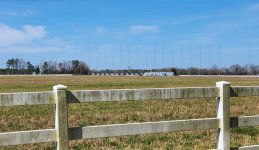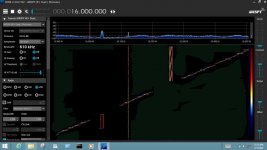I am a real newbie to SDR but find it fascinating. I've noticed that on the waterfall of the SRDConnect and SDRUno, there is an occasional signal that tracks across the entire visible frequency spectrum on the waterfall. As it passes the tuned frequency, it gives a little "pip". It runs from low to high frequency, and takes about a second to span the viewed spectrum on the waterfall, leaving an inclined trace line across the entire waterfall.
I apologize if I'm not using the correct terminology to describe this but has anyone else noticed this? What or who generates it, and could it just be a local interference thing?
Thanks in advance for any thoughts or comments.
I assume yo mean HF range (2-30 MHz). If so, you are almost certainly talking about a radiosonde. These stations are used to study radio conditions. The most often ones heard in the U.S. are the ones at the U.S.N. ROTHR (Relocatable-Over-The-HorizonRadar) sites. (What you see is not the radar but used to tell the radar which frequencies are "good".) This information is also given to Homeland Security and the DEA. There are sites in:
ROTHR-VA New Kent transmit and Chesapeake receive
ROTHR-TX Premont transmit and Freer receive
ROTHR-PR Playa Grande (Vieques) transmit and Ft. Allen (Ponce) receive(There are other sites in the world but the above will be the strong ones in the U.S.)
•Both ionsondes start simultaneously every 12 minutes.
•The 2-20 MHz ionosonde sweeps upwards at 10 s/MHz.
•The 5-28 MHz ionosonde actually sweeps with 100 kHz segments having 20 kHz sub-segments with sweeps at 10 s/MHz (100 Hz/ms). The overall effect is 12.2 s/MHz except when due to exceptions (next bullet).
•The 5-28 MHz ionosonde skips over frequencies for WWV, search and rescue, and other frequencies. There are transmission delays at 7.900, 11.900, and 17.800 MHz.
Sometimes you will only see 1 of the two from a site. Due to the two at each site being different, the two at each site will "cross" *use the same frequency momentarily) around somewhere in the 17 or 18 MHz range--often a little below 18.1 MHz).
(Source: me adn my studies of such things)





